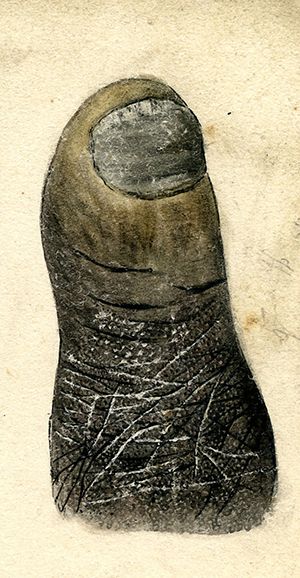Tracing Black, Asian, Minority-Ethnic (BAME) and mixed-race people in Ireland c. 1700–1922, part II
Published in Features, Issue 1 (January/February 2021), Volume 29By Fiona Fitzsimons

Above: An image of the thumb of Nichol, a black servant, drawn by one of the daughters of Prof. William Wallace, surgeon to the Jervis Street Infirmary ‘for the treatment of diseases of the skin’, Dublin, c. 1830s.
(RCSI)
We can trace BAME immigrants by name, place of birth or sometimes by religion. The majority who arrived in Ireland were men—in the armed services, among ships’ crews and as domestic servants, including, before the 1830s, some enslaved.
Armed services
British Armed Service Records noted the name, birth-place and physical description of all enlisted men. We can use the evidence of birth-place to identify a cohort of black and mixed-race recruits, then compare it with the physical description in the records to determine whether or not they were part of this group.
We can apply this method to trace Trumpet-Major George Tombs of the 20th Light Dragoons. Born about 1781 on the island of St Domingo, in 1798 he enlisted in Spanish Town, Jamaica. The regiment shipped to Europe and fought in the Spanish Peninsular War. After 1815 the 20th Dragoons moved to Cahir, Co. Tipperary. George Tombs remained in Tipperary for almost eight years. He was accompanied on his tour of duty by his wife and children. After 1822 Tombs was invalided out of the army and off the pages of recorded history.
This method is very simple but it makes no allowance for immigrant families who assimilated into Irish or British society. Using this method we might examine the service records of Edward Archer, Charles Graham, Richard King, Thomas Leet, George Martin or John MacIntosh if they were born in the West Indies but would disregard these same names if their birth-place was recorded as in Ireland or Britain.
This method also falls down when using documents that recorded less evidence. For example, between 1863 and 1921 the Irish merchant navy registered over 1,000 crew members born in Africa and the Caribbean. They sailed on Irish-registered ships and were frequent visitors to Irish ports. We can surmise their ethnicity but we have no evidence comparable to the army’s ‘physical description’ to prove it.
Servants
W.A. Hart wrote that having a black footman or housemaid carried ‘a social cachet’ among the middle classes of Georgian Dublin. Domestic servants in private employment left few surviving records, although we do have some evidence in newspaper advertisements and notices. One unusual survival, in the William Wallace collection of patient drawings, is a series of anatomical studies of the skin of a black household servant, Nichol. (See ‘Medical drawings’ in HI 26.4, July/August 2018, p. 47). Wallace, surgeon to the Jervis Street Infirmary ‘for the treatment of diseases of the skin’, instructed his two daughters on what he wanted drawn and noted his own observations.
There is no evidence of a black community in Ireland to provide a support network. When we find people it’s often in an institutional setting—a workhouse, hospital or prison. In April 1877 Mrs Georgina Flowers, aged 60 and a Muslim, was transferred from the Mater Hospital to the workhouse in Dublin’s north inner city, while in 1918 Ceden Malup, aged 45, a crew member on the steamship Louisa, was admitted to the South Dublin Union.
After 1700 we find increasing evidence of people of mixed heritage or African descent born in Ireland, from ‘Mulatto Jack’ to the celebrated singer Rachel Baptiste (fl. 1750–73). She was a singer and actress of African descent, born in Ireland. After 1757 she married James Crow, a musician and teacher. Between 1767 and 1773 she continued to tour, performing under her married name. We know of only one child of the marriage, from the baptismal registers in St Munchin’s Roman Catholic church in Limerick City: ‘1768, 10th Nov. Item baptised Jacobum ex Jacobo Crow et Rachele Baptiste, sp. Sara Kelly’.
Even when we find someone in the records it’s very difficult to trace descent. Irish records don’t record colour or ethnicity, and immigrants who remained in Ireland assimilated. We do, however, find evidence of actual black Irish in the records of other countries. From 1790 the US census distinguished between free white and ‘other’ free persons, but only counted enslaved people. After 1850 the census enumerators recorded colour (white, black or mixed race), and from 1890 race or ethnicity. In the 1870 US census we find in the 6th ward of Mobile, Alabama, an Irish-born couple, John White, born c. 1820, whose colour is recorded as ‘black’, and his wife Ann, of mixed race, born c. 1840. Between 1850 and the 1930s there is evidence of hundreds of Irish-born immigrants of black and mixed heritage living in the US.
Fiona Fitzsimons is director of Ennaclan, a Trinity campus company, and of findmypast Ireland.
















